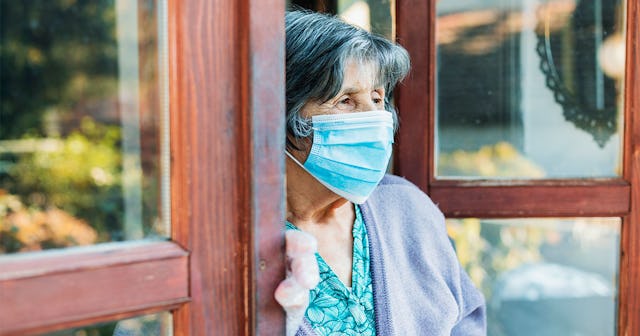If You Have A Loved One In A Nursing Home, There's Good News

There’s no question that nursing homes have been hit tragically hard by the COVID-19 pandemic. Though less than 1% of America’s adult population lives in nursing homes, nearly 40 percent of deaths from COVID-19 have occurred in nursing homes and other long-term care facilities.
That’s an immeasurable degree of loss, an unfathomable amount of heartache.
But finally, after a year of loss and loneliness, there’s a reason to hope. Nursing homes are seeing the lowest amount of COVID cases since May 2020.
The American Health Care Association and National Center for Assisted Living (AHCA/NCAL) recently released a report showing that nursing homes have seen an 82 percent decline in new COVID cases among residents since December 20 of last year.
At its December peak, there were more than 33,000 new COVID-19 cases among nursing home residents. As of February 7, there were just over 6,000 new cases. Not only that, but the report also shows that cases are at their lowest since tracking in nursing homes began in May—from nearly 11,000 cases in May 2020 to just over 6,000 in February 2021.
Likewise, deaths in nursing homes are on the decline. The AHCA/NCAL report found a 63 percent decline in COVID deaths from December 2020 to February 2021.
Put together, the report is evidence of a steep decline that speaks of a very bright tomorrow.
In a press release from the AHCA/NCAL, Mark Parkinson, president and CEO of AHCA/NCAL, described the decline as “incredibly encouraging” and “a major morale booster for frontline caregivers who have been working tirelessly every day for a year to protect our residents.” He also urged caution, and to remember the hard work isn’t done yet.
The Decline Is A Sign That The Vaccines Are Working
Tempura/Getty
The decline in cases and death can be attributed to the vaccination effort. Not surprisingly due to the communal living and the high-risk status of many residents, nursing homes were among the very first prioritized for vaccines when they became available at the end of 2020.
As a result of these efforts, cases in nursing homes are declining faster than cases in the general population. Where nursing homes saw an 82 percent decline, cases in the general population declined only 46 percent.
In an interview with USA Today, Dr. June McKoy, a Northwestern University associate professor of medicine, preventive medicine and medical education, noted that, “Only one thing has been introduced that could have caused this dramatic shift in the number of cases per day… It’s the vaccine.”
If ever we needed more compelling proof that vaccines are working, the positive effect they’ve had on nursing homes is it.
Loosening Restrictive Rules For Vaccinated Individuals In Nursing Homes
Tempura/Getty
Due to the high risk to its residents, nursing homes across the country went on strict lockdown in the early days of the pandemic. Many residents have been unable to see or spend time with family in any meaningful way. After a year spent in isolation, that takes a toll.
“I don’t think we really understand how seniors are struggling,” McKoy said. “They are starving for human contact.”
As the vaccination rollout speeds up and more residents and staff receive their vaccine, Parkinson urges federal, state, and local governments to review the current guidance around nursing homes, including the rules restricting visitors and group activities. Maybe not a free-for-all—some nursing homes may still require advance scheduling, may limit the time of each visits, and/or require health screenings or negative COVID tests before visiting—but at least some social activity.
“With millions of residents and caregivers now fully protected thanks to the vaccines, residents must be able to safely reengage in meaningful activities and be reunited with their loved ones,” says Parkinson.
Most recent guidance supports Parkinson’s argument. The CDC guidance permits fully vaccinated individuals to:
- Visit with other fully vaccinated people indoors without wearing masks or physical distancing
- Visit with unvaccinated people from a single household who are at low risk for severe COVID-19 disease indoors without wearing masks or physical distancing
With that in mind, in December, AHCA/NCAL launched a nationwide campaign to encourage all long term care residents, families and staff members to get vaccinated. Their goal is to get 75 percent of all long term staff vaccinated by June 30, 2021.
In order to make that happen, long-term care and nursing home staff must consent to vaccination, as well. As of early February, a study in the Journal of the American Medical Association found that less than half of nursing home staff accepted a vaccine when offered. This suggests there’s more work to be done in educating the public about vaccine safety.
Overall, this most recent report by the AHCA/NCAL is proof that we are within walking distance of the light at the end of the tunnel. It’s proof that very soon we can take a collective deep breath. It’s, at the very least, proof that our most vulnerable are getting the protection they need. And that’s good news for all of us.
Information about COVID-19 is rapidly changing, and Scary Mommy is committed to providing the most recent data in our coverage. With news being updated so frequently, some of the information in this story may have changed after publication. For this reason, we are encouraging readers to use online resources from local public health departments, the Centers for Disease Control, and the World Health Organization to remain as informed as possible.